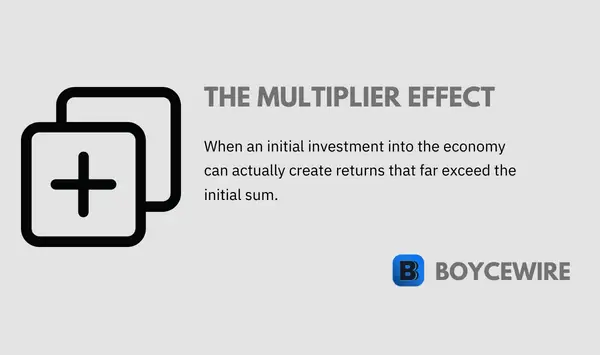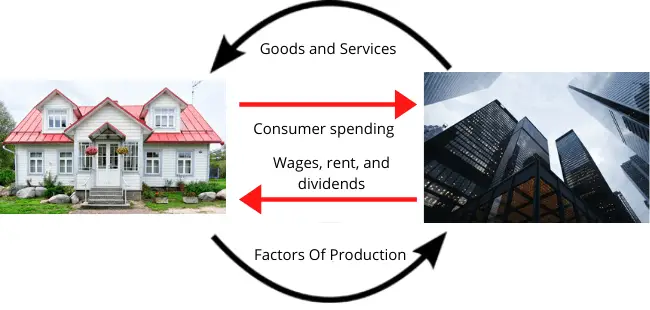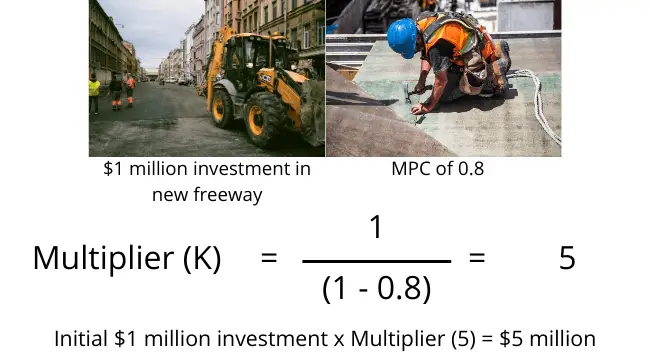The Multiplier Effect: Definition, Formula & Example

What is the Multiplier Effect
The multiplier effect refers to how an initial injection of money into the circular flow of income can stimulate economic activity in excess of the initial investment. For example, if the government invests $10 billion into a new infrastructure project, the money goes to the businesses that pay their employees.
They then buy goods which stimulate another business who then pays their employees who buy more goods. So the initial $10 billion passes through multiple hands, stimulating economic activity as it goes – creating an effect in excess of the initial $10 billion.
Another way we can look at the multiplier effect is as a set of dominos lined up. Pushing the first one over sets in motion the next domino to fall which then triggers the next, creating the ‘domino effect’ – another name for the ‘multiplier effect’ that acts in the same way.
There are many names for the multiplier effect – another is the Keynesian Multiplier. Named after its creator, John Maynard Keynes, who believed that fiscal stimulus would provide a greater return on investment due to the multiplier effect. So an initial investment by the government would stimulate the economy in excess of the actual amount invested.
Key Points
- The multiplier effect refers to how much an initial investment can stimulate the wider economy over and above the initial amount.
- The multiplier effect is linked to marginal propensity to consume in the fact that the more likely consumers are to spend, the higher the multiplier.
To help further understand, we need to look at the circular flow of income. This is the flow of money between businesses and employees/consumers. As businesses grow, they hire more people. In turn, those employees spend that money at other businesses who then hire more people. The cycle then continues to flow, creating a multiplying effect.

This multiplying effect is influenced by two factors – injections and leakages. Injections refer to cash that is being spent by consumers or investments made by businesses. This enhances the multiplier effect as the initial sum is sent through the circular flow of income – passing through businesses to employees and back to businesses again.
By contrast, we have ‘leakages’ – also known as saving. These have a negative impact on the multiplier because the money is being withheld from the circular flow of income. The money isn’t passing through the economy in the same way consumer spending is.
This leads us to marginal propensity to consume – which directly impacts the multiplier effect. The higher the marginal propensity to consume, the higher the multiplier effect. When people spend a high proportion of their incomes, they have a high marginal propensity to consume. So a $10 billion fiscal stimulus package will have a strong multiplier effect.
By contrast, when consumers have a low marginal propensity to consume, it means they are more likely to save additional income rather than spend it. This reduces the multiplier effect.
Multiplier Effect Formula
The marginal propensity to consume is a crucial part of the multiplier effect formula. If people are likely to spend the money coming in, the multiplier will be higher. The money will be spent at a much faster rate – thereby stimulating the economy.
The multiplier effect can we calculated using either of the two formulas that represent either the marginal propensity to consume (mpc) or the marginal propensity to save (mps).

The marginal propensity to consume refers to the percentage of income the consumer spends. So for an additional $1, how much of that will be spent, and how much will be saved. The amount spent is referred to as the marginal propensity to consume (mpc) and the amount saved is the marginal propensity to save (mps).
Multiplier Effect Example
Let us say the government undertakes an investment project to build a new freeway worth $1 million. The government pays a construction firm to undertake the work, with the employees getting paid for such.
As the government spends $1 million, this increases GDP by the same amount. However, the $1 million then passes to the construction workers who may then go spend that money going to the movies, buying video games, or a new car. Whatever the money is spent on, it is stimulating another part of the economy.
If we say the marginal propensity to consume is 0.8, it means that for each $1 in additional income the workers get, they spend $0.80. In turn, $0.8 million of the initial $1 million is spent by the workers. That money then goes to the employees of the next business who spend 0.8 of that income, which amounts to $0.64 million. This then goes on and on and on.
We can, therefore, calculate the multiplier effect using the formula:
Multiplier Effect (k) = 1 / (1 – mpc)
In this case, where the mpc is 0.8, this would lead to the formula:
1 / (1 – 0.8) = 5
Therefore, the multiplier is 5 – which means the initial $1 million investment would provide a $5 million stimulus to the wider economy.

FAQs on The Multiplier Effect
The multiplier effect refers to how an initial injection of money into the circular flow of income can stimulate economic activity in excess of the initial investment.
The multiplier effect works as the initial injection of money goes to employees that then spend the money at another business. In turn, this stimulates employment and those employees get paid, who then spend at another business. This cycle continues to go on in a ‘multiplying’ fashion.
A low multiplier means that any government investment has little impact on the economy as the money is not circulating and stimulating activity. By contrast, a high multiplier means people are spending most of the money they receive, which stimulates other economic activities associated with what they are purchasing.
About Paul
Paul Boyce is an economics editor with over 10 years experience in the industry. Currently working as a consultant within the financial services sector, Paul is the CEO and chief editor of BoyceWire. He has written publications for FEE, the Mises Institute, and many others.

Further Reading
 Free Market: Definition, Pros, Cons & Examples - A free market is where the people in an economy are free to engage in economic activities and transactions without…
Free Market: Definition, Pros, Cons & Examples - A free market is where the people in an economy are free to engage in economic activities and transactions without…  Conspicuous Consumption: Definition & Examples - Conspicuous consumption is where the consumer spends excessive amounts in order to highlight their wealth to society.
Conspicuous Consumption: Definition & Examples - Conspicuous consumption is where the consumer spends excessive amounts in order to highlight their wealth to society.  The Importance of Free Trade - True free markets don’t exist anywhere in the world. This is because free markets and free trade go hand in…
The Importance of Free Trade - True free markets don’t exist anywhere in the world. This is because free markets and free trade go hand in… 
